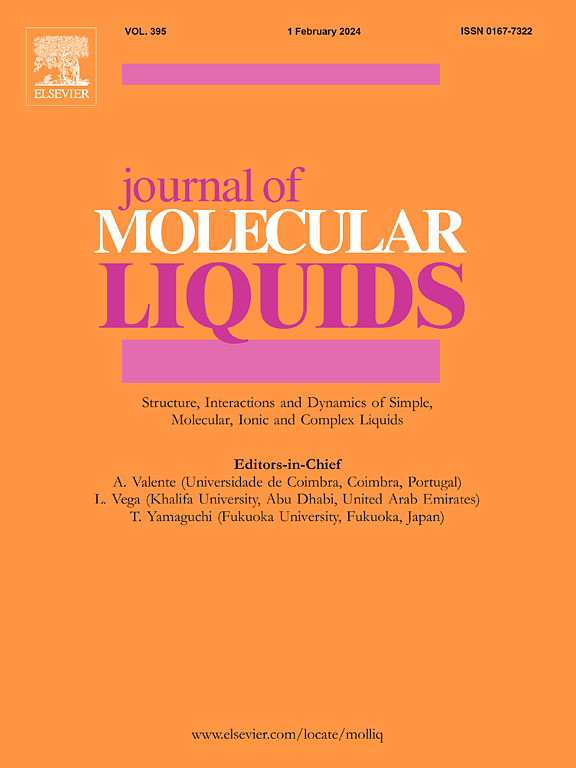mwcnt定制的PVA膜通过渗透蒸发增强醋酸乙酯-乙醇-水三元混合物的脱水
IF 5.3
2区 化学
Q2 CHEMISTRY, PHYSICAL
引用次数: 0
摘要
乙酸乙酯是一种高度相关且环保的工业溶剂,用于各种制药,油漆和清漆行业,近年来需求不断增加。本研究利用多壁碳纳米管(MWCNTs)的小尺寸和高表面积增强了pva基新型混合基质膜,通过渗透蒸发分离乙酸乙酯、乙醇和水的三元混合物。合成的膜对不同的纳米填料负载进行了彻底的表征,并评估了膨胀程度。利用实验室渗透蒸发装置对膜的性能进行了评估。研究了各种工艺参数,如给水浓度、下游压力和温度,以解释总通量、部分通量、选择性和分离指数等关键指标。估计了PVA、1%和2% MWCNT膜的温度依赖活化能。在进料浓度为13wt %水的条件下,掺杂2wt %多壁碳纳米管(MWCNTs)的膜的渗透通量为0.226 kg/m2·h,选择性为326.36,活化能为12.33 kJ/mol。超过100小时的长期稳定性证实了膜的耐久性。通过与工业膜的对比分析,揭示了mwcnt掺杂膜的优越效率和工业潜力。因此,本研究强调了混合基质膜通过渗透蒸发净化工业废水中的有机溶剂的应用,利用生态友好和经济高效的方法。本文章由计算机程序翻译,如有差异,请以英文原文为准。
MWCNT-tailored PVA membranes for enhanced dehydration of ethyl acetate-ethanol-water ternary mixture via pervaporation
Ethyl acetate, a highly relevant and eco-friendly industrial solvent used in various pharmaceutical, paint, and varnish industries, has seen an increase in demand in recent years. This study reinforced a PVA-based novel mixed matrix membrane with multi-walled carbon nanotubes (MWCNTs) due to their small dimensions and high surface area, to separate a ternary mixture of ethyl acetate, ethanol, and water by pervaporation. The synthesized membranes were thoroughly characterised for different nanofiller loadings, and the degree of swelling was assessed. The membrane performance was also evaluated using a laboratory pervaporation setup. Various process parameters, such as feed water concentration, downstream pressure, and temperature, were studied to interpret key indicators like total flux, partial fluxes, selectivity, and separation index. The temperature-dependent activation energy of the PVA, 1 %, and 2 % MWCNT membranes was estimated. At a feed concentration of 13 wt% water, the membrane doped with 2 wt% multi-walled carbon nanotubes (MWCNTs) exhibited a permeation flux of 0.226 kg/m2·h, a selectivity of 326.36, and an activation energy of 12.33 kJ/mol. Long-term stability of over 100 h confirmed the membrane’s durability. Comparative analysis with commercial membranes revealed the superior efficiency and industrial potential of the MWCNT-doped membranes. Consequently, this study highlights the application of mixed matrix membranes through pervaporation to purify organic solvents from industrial streams, utilising eco-friendly and cost-efficient methodologies.
求助全文
通过发布文献求助,成功后即可免费获取论文全文。
去求助
来源期刊

Journal of Molecular Liquids
化学-物理:原子、分子和化学物理
CiteScore
10.30
自引率
16.70%
发文量
2597
审稿时长
78 days
期刊介绍:
The journal includes papers in the following areas:
– Simple organic liquids and mixtures
– Ionic liquids
– Surfactant solutions (including micelles and vesicles) and liquid interfaces
– Colloidal solutions and nanoparticles
– Thermotropic and lyotropic liquid crystals
– Ferrofluids
– Water, aqueous solutions and other hydrogen-bonded liquids
– Lubricants, polymer solutions and melts
– Molten metals and salts
– Phase transitions and critical phenomena in liquids and confined fluids
– Self assembly in complex liquids.– Biomolecules in solution
The emphasis is on the molecular (or microscopic) understanding of particular liquids or liquid systems, especially concerning structure, dynamics and intermolecular forces. The experimental techniques used may include:
– Conventional spectroscopy (mid-IR and far-IR, Raman, NMR, etc.)
– Non-linear optics and time resolved spectroscopy (psec, fsec, asec, ISRS, etc.)
– Light scattering (Rayleigh, Brillouin, PCS, etc.)
– Dielectric relaxation
– X-ray and neutron scattering and diffraction.
Experimental studies, computer simulations (MD or MC) and analytical theory will be considered for publication; papers just reporting experimental results that do not contribute to the understanding of the fundamentals of molecular and ionic liquids will not be accepted. Only papers of a non-routine nature and advancing the field will be considered for publication.
 求助内容:
求助内容: 应助结果提醒方式:
应助结果提醒方式:


